Imagine converting more leads into clients. Picture perfect, right? Well, with an effective business proposal, you can turn it into a reality!
A compelling business proposal can be the key to securing new opportunities and driving growth. It showcases your professionalism and highlights the unique value you bring to the table.
So how do you write a business proposal that translates your value proposition and makes an organization say “Yes” with hearts in their eyes?
We’ve got you covered! In this guide, we’ll share a step-by-step guide on how to write a business proposal with tips and a template. Let’s dive in.
What is a business proposal?
A business proposal is a formal document presented to a prospective client, investor, or partner to secure a specific business agreement or opportunity. It outlines the proposed services or products, their benefits, costs, and why the company is the best fit to deliver the solution. The purpose of a business proposal is to persuade the recipient to accept the proposal.
Business proposal vs. business plan
It’s easy to confuse business proposals and plans since both involve pitching at some point.
Think of writing a business plan as crafting a compass guiding your overall direction. It details your vision, target market, who you compete with, marketing strategies, and financial goals for the next few years. This internal document acts as a roadmap for your company’s growth.
Whereas a business proposal zooms in on a specific prospective client. It highlights how your products or services can solve their unique problems and help them achieve their goals.
In essence, a business plan describes where your company is heading. While a business proposal offers a solution for a potential customer.
Types of business proposals
There are several types of business proposals, each serving a different purpose. Here are some common types:
Unsolicited business proposals
Unsolicited proposals are submitted to potential clients without a formal request. They work like cold emails. You reach out with a solution you believe fits the potential client’s needs.
They are less customized since you haven’t spoken directly with the prospect. But that’s okay. Market research can help identify common pain points.
You can highlight these issues and showcase your solution, proving why you’re the best option. Also, implement dmarc (Domain-based Message Authentication, Reporting & Conformance) policy to ensure that your business proposals align with best email practices.
Formally solicited business proposals
You send formally solicited proposals after an official request. For example, you have a meeting with a prospect and now they want to see a document where they can read more details.
A formally solicited business proposal is going to be super customized since you’ll have tons of key information about your prospective customer. Unlike unsolicited, you’ll be one step closer to securing the project.
Informally solicited business proposals
Informally solicited proposals are written in response to a request that isn’t a formal request for proposal (RFP). The potential client may have expressed interest in your products or services, and you write a proposal to outline the specifics of your offer. You’ll need to work harder to understand their business and need to create a proposal.
How to write a business proposal?
Now, that you know the types of business proposals, let’s get to the main point—how to write a well-written business proposal:
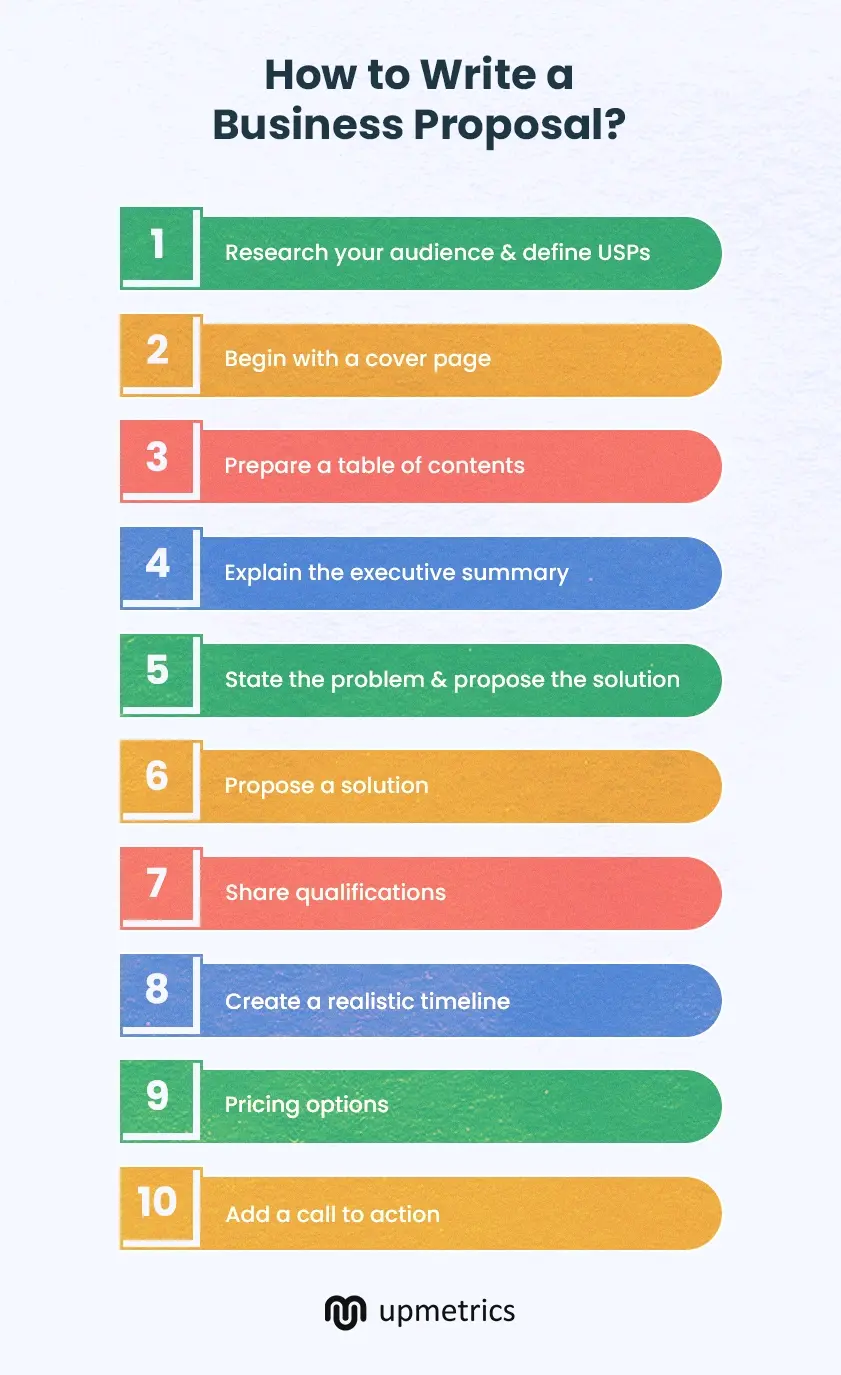
1. Research your audience & define USPs
You can’t create an effective formal business proposal if you don’t know your client well. The most successful business proposals prioritize the client’s perspective.
Research to understand the client’s industry, competitors, target market, and recent company news. Analyze their social media presence and press releases.
Also, clearly articulate how your product or service addresses the client’s specific needs and pain points identified in your research.
Don’t just list features; explain how each feature benefits the potential client. Show what makes your organization unique and the best choice to solve its problems compared to competitors. List all the unique value proposition points of your product or services.
Use data, client testimonials, or case studies to demonstrate the positive impact you’ve delivered.
2. Begin with a cover page
A cover page is the first thing your audience will see in the entire proposal. So, ensure it’s clear, concise, and engaging enough for your audience to move forward.
It should include:
- Proposal title page
- Date of submission
- Company information (logo, name, tagline, etc)
- Your name, title, and contact details
- Prospective client’s name, title, and contact details
Example of the cover page:
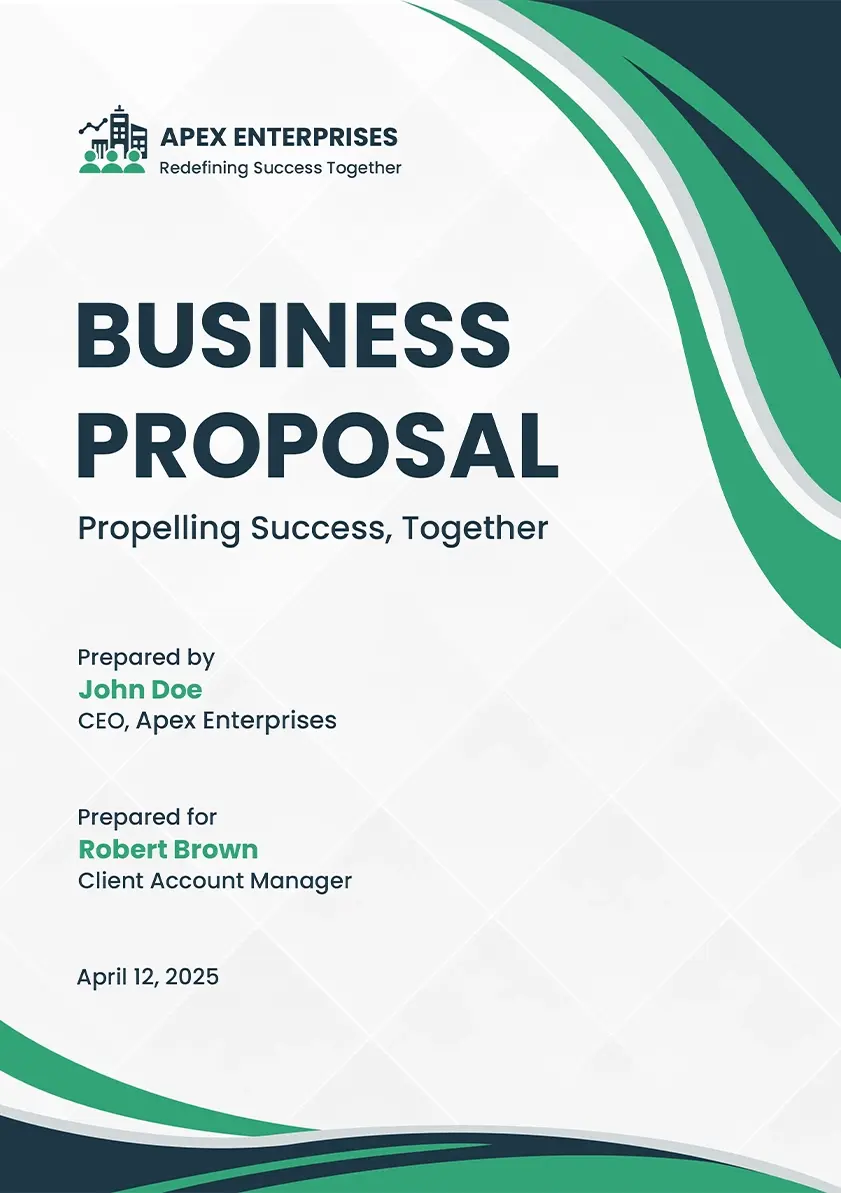
Avoid complicated design and technical language. Your prospect can easily skip your proposal document if it’s not scannable.
3. Prepare a table of contents
A table of contents (TOC) section is crucial for any detailed business proposal. It allows your potential clients to quickly locate the sections they are most interested in. For both physical and electronic proposals, you need a TOC:
Electronic documents
For electronic versions of your proposal, a clickable TOC is beneficial. Most word processors can generate these automatically using your document’s headings, allowing readers to jump directly to sections of interest.
Physical documents
In a printed business proposal document, page numbers are essential. Ensure your TOC includes accurate page numbers to guide readers through the document.
A well-organized TOC ensures that all relevant information is easily accessible, preventing any frustration and increasing the likelihood of a positive response.
4. Explain the executive summary
The executive summary, arguably the most crucial part of any business proposal, explains why you’re submitting the proposal and why you’re the best choice to address the potential client’s problem.
Think of your executive summary as a value proposition that highlights what makes your company unique and the specific benefits the prospective client will gain from partnering with you.
Customize your executive summary to align with the client’s needs. Even if you’re sending the proposal to multiple potential clients, it should feel personalized for each one. Don’t worry, it’s simple. Just adjust the summary to address the unique challenges of different clients.
Apart from that, consider your tone carefully. The style you use for a company that rents party buses to college students should differ from that for a company offering financial advice to clients.
Aim to keep your executive summary between two to four pages, because there will be other sections in which you have to include things in detail. Here’s what an executive summary should include:
A hook statement
Right after the cover page, the start of your proposal needs something engaging and catchy about your business to set the tone. This is where a hook statement comes into play.
For example, “Imagine increasing your online sales by 20% within the next quarter. Our data-driven marketing strategy can make it a reality.” This hook focuses on a positive outcome the client could achieve with the help of your marketing agency, sparking their interest.
Business introduction
Provide a short introduction to your company and its capabilities. This section should give the reader confidence in your expertise and experience.
Purpose of your business
Clearly state the purpose of your business proposal. This should align your services with the client’s specific needs.
For example, “The purpose of this proposal is to present our customized marketing strategy to boost your online sales and enhance your brand presence. By addressing your unique challenges, we aim to deliver a targeted approach that aligns with your business objectives, increases market share, improves customer engagement, and drives revenue growth.”
Call to action
Encourage the reader to continue reading or take the next step (e.g., schedule a meeting or make a call).
5. State the problem & propose the solution
A solid problem statement does more than merely state a problem—it provides context, demonstrates your understanding of the client’s challenges, and sets the stage for the solution.
By highlighting the problem’s impact on the client’s business—such as revenue loss, decreased market share, or operational inefficiencies—you create a sense of urgency.
This establishes your credibility and aligns your solution with the client’s needs, making them more likely to consider your proposal seriously.
Here are the steps to write the problem statement efficiently:
- First, understand the client’s issues
- Describe what exactly they’re facing
- Explain context
- Keep it specific
6. Propose a solution
Finally, this is the section where you have to explain in detail the solution you were talking about in the executive summary. Begin by briefly recapping the problem, then introduce your proposed solution.
Mention how your solution directly addresses the identified issue. Highlight your product’s unique selling points (USPs) and provide a detailed explanation about it.
Whether you’re addressing past or new clients, they highly value this section. So ensure your proposed solution is tailored to their specific needs and directs all aspects of the problem statement.
Additionally, specify the deliverables, including their quantity, delivery methods, and timeframe, to provide a clear and comprehensive picture of what the potential customer can expect.
For instance, “We understand stagnant online sales are a concern. Our data-driven marketing strategy tackles this by increasing brand awareness, driving qualified traffic, and optimizing website conversions.
Expect a 30% website traffic increase in Q1 and a 20% online sales boost in Q2 through improved conversion rates.
Targeted social media campaigns will reach your ideal customer base, driving qualified traffic to your website”.
7. Share qualifications
In the previous section, you already briefly highlighted what makes your company qualify to solve your customers’ problems. In the qualifications section, you’ll have to elaborate on why your business is the best suited.
Here, detail your company’s experience by highlighting relevant industry expertise. Don’t forget to introduce key team members who will work on the project, emphasizing their qualifications.
List relevant certificates and awards, if you’ve won any. Also, provide social proof to support the claims. Include case studies from past clients, customer testimonials, endorsements from trusted industry experts, and any other evidence that showcases the value you provide.
8. Create a realistic timeline
Moving forward, provide a timeline of how and when you will complete all your deliverables. This timeline provides a clear overview of the project flow, key milestones, and expected completion dates.
Identify key phases like planning, design, development, testing, and deployment. Set realistic timeframes for each task, considering the complexity, available resources, and potential risks. Include extra time for unexpected delays.
Review the timeline with your team to ensure it’s realistic and achievable, and adjust as necessary based on their feedback. You can do this by designing a flowchart or adding a roadmap with deadlines.
9. Pricing options
The pricing section explains how much it will cost the client for you to solve their problem. It’s where things can get a bit tricky because you would not want to under-or-over price your product or services. It should include:
- A detailed pricing breakdown, including all the packages, tiers, and add-ons.
- Description of how your pricing point matches your product or services.
- An FAQs section to address more pricing-related questions.
- Various packages for different needs and budgets.
Remember, a single flat fee will make your entire proposal a yes or no question, which is easy to reject. Therefore, adding pricing options provides clients with more options to think about.
10. Add a call to action
What steps should the client take next? Make it crystal clear by crafting an effective call to action.
Tell the client how to accept the business proposal or connect with your company. This may involve scheduling a follow-up meeting, signing a contract, making a payment, or offering feedback on the proposal.
For example, “After reviewing our proposal, we are confident that our marketing strategy can significantly boost your online sales and enhance your brand presence. To take advantage of this opportunity and start seeing results, we invite you to schedule a meeting with our team. Let’s work together to achieve your business goals. Contact us now at [Your Contact Information].”
Tips to make your business proposals stand out
Creating standout business proposals involves several key strategies to capture your potential client’s attention and convince them of your value. Here are some tips:
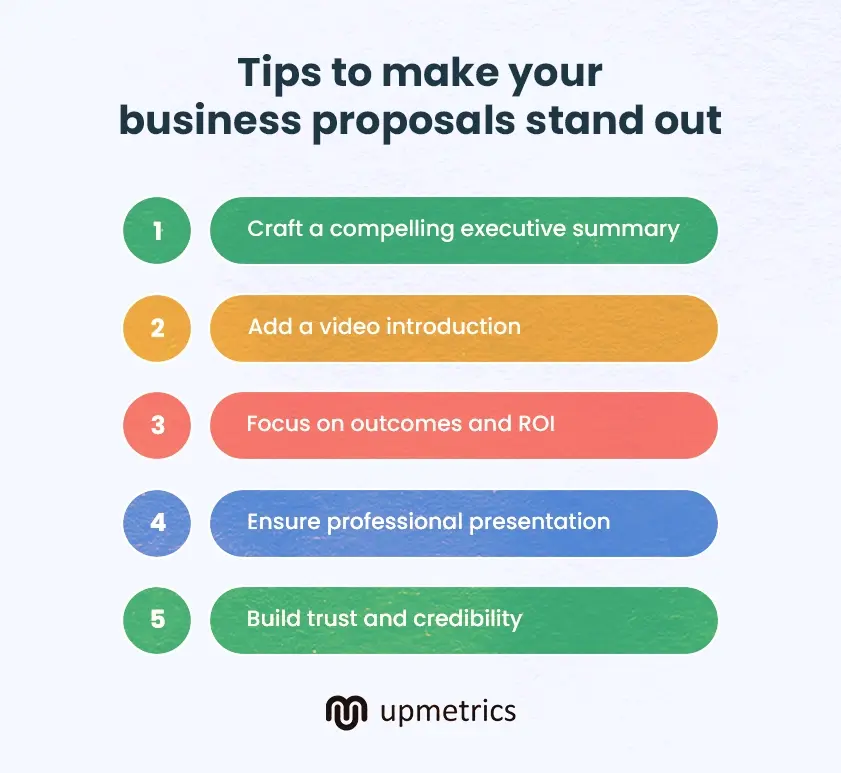
1. Craft a compelling executive summary
The executive summary is crucial as it sets the tone for the rest of the proposal. It should be clear, concise, and engaging, summarizing the key points in a way that grabs the client’s attention.
2. Add a video introduction
Try adding a video introduction. It’ll make your proposal more engaging and personable. In the video, introduce yourself and your team, and briefly explain how you’re the best and the rest isn’t.
Small things like this can help your proposal stand out by showing that you have paid attention to the details to grab the client’s attention.
3. Focus on outcomes and ROI
With the help of visual elements like charts or graphs, emphasize the potential return on investment (ROI). Back the ROI with sufficient data and metrics to quantify the benefits of your solution.
Also, mention how your business provides long-term value to the client. Showing how your solution saves money and benefits the client’s strategy can strongly persuade them to choose you.
4. Ensure professional presentation
A professionally presented proposal can make a strong impression. Use clean and consistent formatting for a professional look, avoid typos, and keep the language crisp.
Also, add visual elements in between to make your proposal engaging. A well-presented proposal can differentiate you from competitors and leave a lasting impression on the client.
5. Build trust and credibility
Highlight your team’s qualifications and relevant experience to showcase your ability to deliver the project effectively.
Include case studies or reviews from previous clients to build trust and showcase the positive impact of your work.
Business proposal templates and resources
Now that you’re familiar with what to include in a business proposal, you’ll need resources to flesh it out, get inspired, and enhance your proposal writing skills.
You can use it to:
- Write a well-rounded proposal to impress your prospective clients.
- Ensure that you don’t miss out on relevant details.
- Crack deals that you want.
- Make the process faster and smoother.
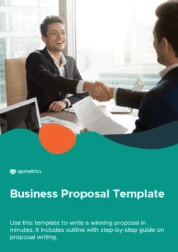
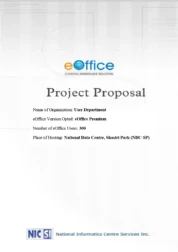
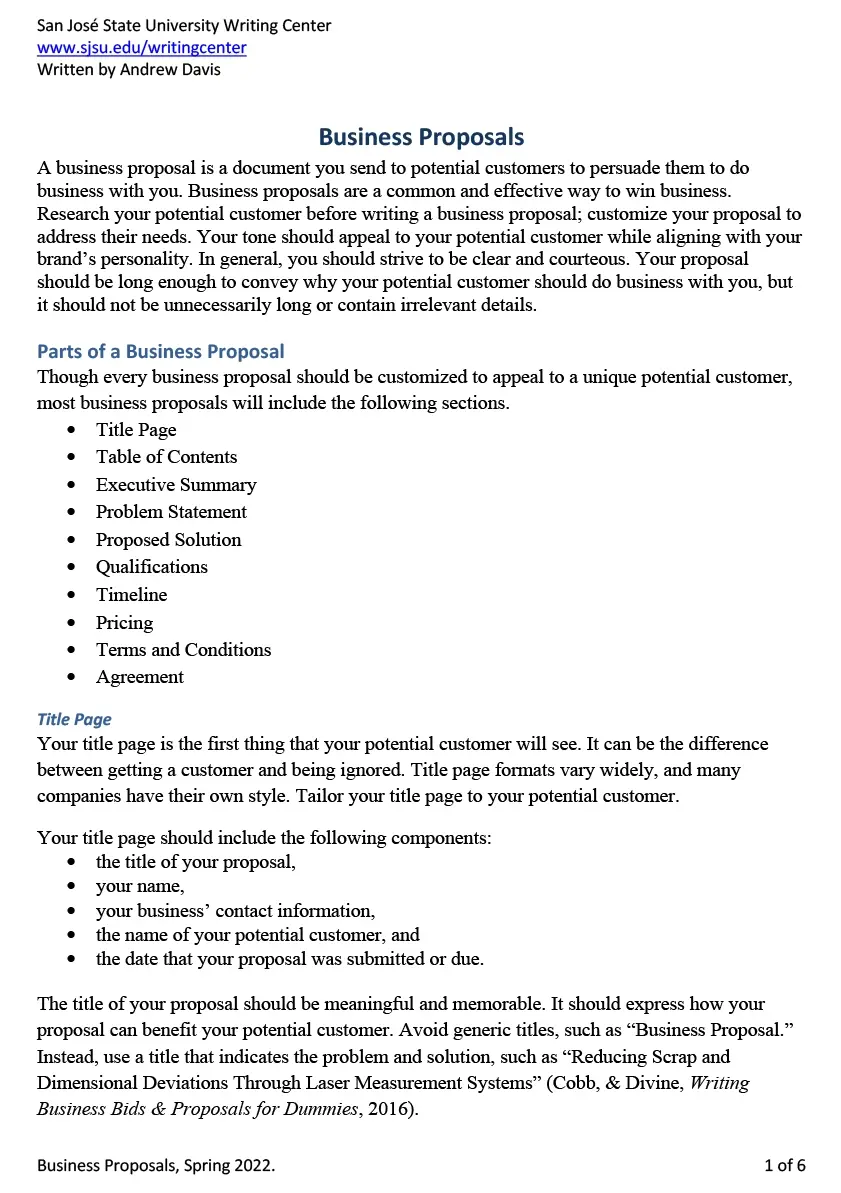
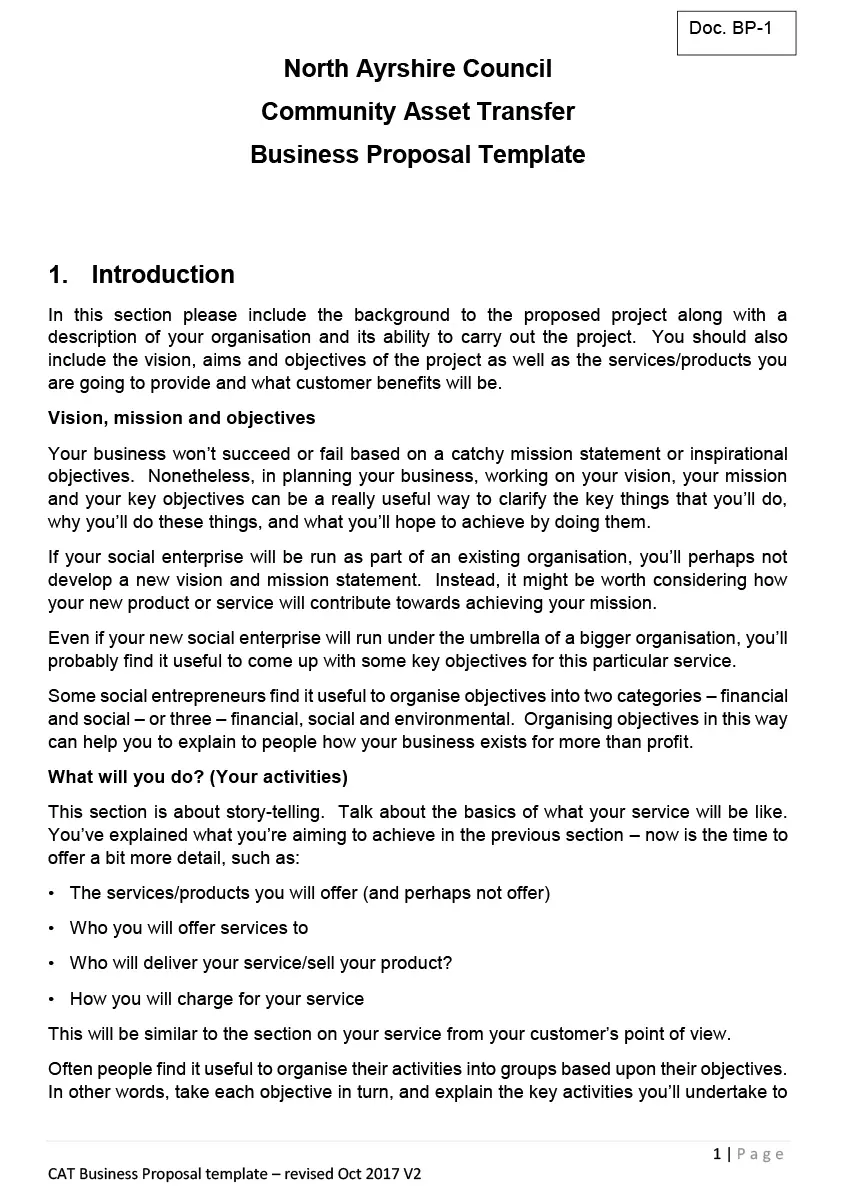
Conclusion
So that’s it for today!
Remember, a well-crafted business proposal is more than just a document; it’s a strategic tool that can help you win new opportunities, drive growth, and ultimately, convert leads into loyal clients.
So, use the tips and resources provided in this guide to create business proposals that leave a lasting impression and set you apart from the competition.
If it seems challenging, then consider exploring Upmetrics’ business proposal template for a smoother process. Upmetrics can help you create professional, compelling proposals and business plans that impress your clients.
